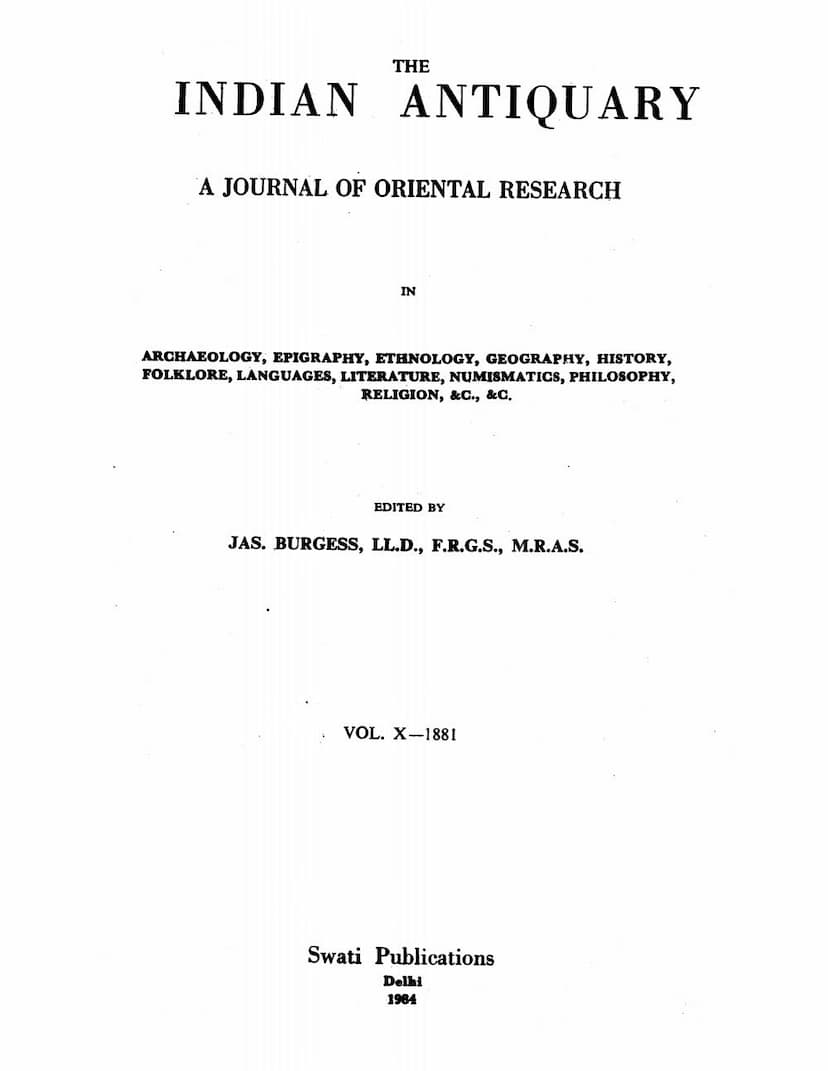Indian Antiquary Vol 10
Added to library: September 1, 2025

Summary
Here's a comprehensive summary of the provided Jain text from the Indian Antiquary, Vol. 10, edited by Jas. Burgess:
Overview:
The Indian Antiquary, Vol. 10 (1881), published by Swati Publications, is a collection of scholarly articles focusing on various aspects of Oriental research, including archaeology, epigraphy, ethnology, history, folklore, languages, literature, numismatics, philosophy, and religion. While the entire volume covers a broad range of topics, this summary will focus on the content relevant to Jainism, as indicated by the limited scope of Jain-specific material within the provided text.
Jain Content:
The provided text primarily consists of the table of contents and the beginning of several articles. However, the table of contents reveals that Professor G. Bühler contributed two articles that are directly relevant to Jainism:
- "SANSKRIT MANUSCRIPTS in Western India": This article, beginning on page 100, is a report by Dr. G. Bühler detailing his examination of ancient Jain Bhandars (collections of manuscripts) in Western India, specifically in Anhilwad Patthan and Cambay. He highlights the importance of these collections for their age and accuracy, noting that they contain copies of ancient works not widely studied anymore but of great interest to scholars of Indian history and philosophy. He emphasizes the value of these manuscripts in understanding the development of Sanskrit literature in Southern India.
- "NOTE on the word Siddhart used in Inscriptions": This note, by Prof. G. Bühler on page 278, specifically addresses the usage of the word "Siddhart" in inscriptions, likely exploring its linguistic or historical significance within the context of ancient Indian texts.
Other Relevant Content (Indirectly related to Jainism or broader Indian context):
While the direct Jain content is limited to the mentioned articles by Prof. Bühler, the volume as a whole covers topics that would be of interest to Jain scholars due to the interconnectedness of Indian religious and cultural history:
- Inscriptions: A significant portion of the volume is dedicated to the transcription and translation of various inscriptions, including Sanskrit and Old-Canarese inscriptions. These often pertain to dynasties and religious traditions that interacted with or influenced Jainism. For example, articles by J. F. Fleet discuss inscriptions related to the Western Chalukyas, Rashtrakutas, and Vijayanagara kings, whose reigns often saw the patronage or interaction with Jain communities.
- Religious Texts and Philosophy: The volume includes discussions on various religious and philosophical topics, such as readings from the Bharhut Stupa (which contains early Buddhist imagery and inscriptions that offer comparative insights into religious art and epigraphy of ancient India, including periods relevant to early Jainism). Rev. S. Beal's article on "The Chong-lun Sutra or Pranyamola-Sastra of Nagarjuna" delves into Mahayana Buddhist philosophy, a tradition that arose in a similar socio-religious milieu as Jainism.
- Folklore and Customs: Articles on folklore, such as "Folklore in the Punjab" and "Bombay Beggars and Criers," offer insights into local customs, beliefs, and social practices that may have parallel or contrasting elements with Jain traditions.
- General Oriental Research: The breadth of topics covered, from the "Indian Travels of Chinese Buddhists" to "Sanskrit Manuscripts in Western India," demonstrates the comprehensive approach of the journal in documenting and analyzing the rich tapestry of Indian civilization.
Overall Significance for Jain Studies:
The Indian Antiquary, Vol. 10, serves as a valuable resource for understanding the historical and cultural context in which Jainism flourished. Prof. G. Bühler's contributions, in particular, highlight the importance of manuscript studies for understanding the broader religious landscape of Western India and the specific terminology used in inscriptions. The volume's focus on epigraphy and historical records provides essential primary data for scholars of Jainism, allowing them to place Jainism within its historical and geographical context and to understand its interactions with other Indian religions.
In Summary:
The provided text from the Indian Antiquary, Vol. 10, highlights the contributions of Prof. G. Bühler to the study of Jainism through his work on Sanskrit manuscripts and inscriptions. It underscores the journal's role as a platform for rigorous academic research into the diverse aspects of Indian history and culture, providing valuable resources for scholars across various disciplines, including Jain studies.